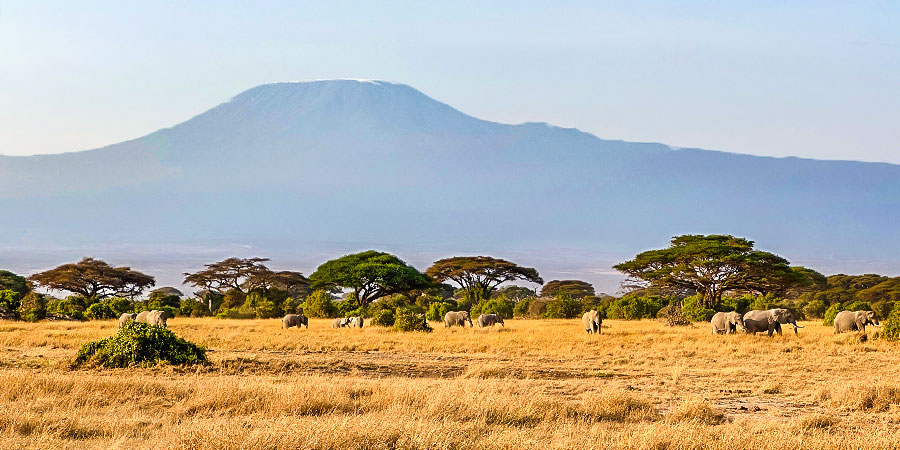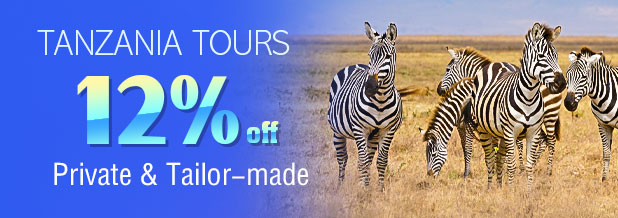Top Things to Do in Tanzania
There are plenty of scenic spots around the country. Here, we will introduce them one by one in terms of regions.

Mount Kilimanjaro
|
Central Tanzania
The major city here is Dodoma, the capital of Tanzania. Although it is not so developed as Tanzania’s old capital- Dar es Salaam, Dodoma is making great progress these years.
Kondoa Rock Art Sites is on the eastern edge of the Great Rift Valley in Dodoma Province. The cliffs and caves formed by crustal movement was used to record and display the people’s lives and beliefs who once lived there in the form of rock paintings.
Ruaha National Park
Ruaha National Park is the second largest park of the country with convenient transportation. You can see various kinds of plants and large mammals in the park, such as impala, African antelope, cheetah, and leopard.

Ngorongoro Crater Tanzania
|
Northeastern Tanzania
The major cities are Arusha and Moshi. There are Mount Kilimanjaro National Park, Arusha National Park, Serengeti National Park, Lake Manyara National Park and Ngorongoro Conservation Area.
Mount Kilimanjaro
Mount Kilimanjaro, called the “Roof of Africa”, is the highest mountain in Africa. On the way from the foot to the top, you can enjoy the scenery usually seen in tropical area, temperate zone and frigid zone.
Arusha National Park
There are three famous scenic spots in Arusha National Park - Ngurdoto Crater, Momela Lake and Mount Meru.
Serengeti National Park and Ngorongoro Conservation Area with abundant animal species are great places to watch wild animal migrations.

Getting into the Ngorongoro Conservation Area
|
Northwestern Tanzania
Lake Victoria
This is the largest lake in Africa. From 1860 to 1863, when British explorers John Hanning Spike and Grant came here to investigate the source of the Nile River, they named the lake after Queen Victoria. There are plenty of islands and reefs in the lake.
Lake Tanganyika
Lake Tanganyika, the second deepest lake in the world, is on the east border of Tanzania. It is known as the kingdom of birds because of its abundant bird species and quantities, of which the most popular one is flamingo.

|
Southern Tanzania
Lake Malawi
Lake Malawi is famous for its majestic and beautiful scenery because of its location. Some parts are surrounded by high cliffs, with mighty waves beating the shore. While in other parts, the stream flows with continious susurrus. Known as the most magnificent lake in southern Africa, Lake Malawi attracts thousands of tourists from all over the world every year. In 1984, Lake Malawi National Park was listed as “World Natural Heritage” by UNESCO.
Southeastern Tanzania
The major city is Dar es Salaam, the former capital of Tanzania. There are a lot of attractions around here. You can enjoy the sunshine on the beach in Mbudya Island or on Coco Beach, have fun and get relaxed in Kunduchi Water Park, and visit National Museum and House of Culture, which exhibits many primitive fossils, including those excavated from the Oduwayi Gorge, as well as other relics from British and German colonial periods.
Zanzibar

On Zanzibar Island, Tanzania
|
Zanzibar consists of two major islands, Unguja and Pemba. Because of its mild and pleasant climate, turquoise-like sea water and white beaches, Zanzibar Island has been listed as one of the three must-see destinations in East Africa by “American Journal of Tourism”. Zanzibar is famous for its cloves, accounting for 4/5 of the world’s cloves, hence known as “the most fragrant place in the world” and “Fragrant Island”. The Stone Town of Zanzibar, the capital of Zanzibar Island with a long history and unique characteristics, has been listed as a world cultural heritage. In addition, the island has a multicultural integration of traditional African culture, Islamic culture and Indian culture, which is also a highlight here.


